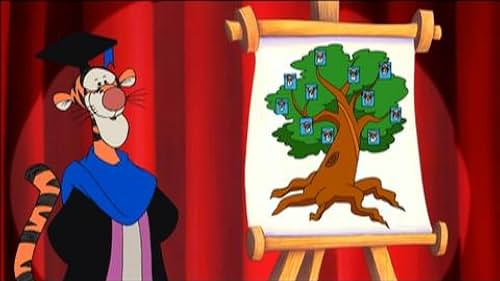A.A. Milne(1882-1956)
- Writer
- Soundtrack
Alan Alexander Milne (signing with the initials A. A. ) was an English novelist, short story writer, poet, and playwright from London. He is primarily remembered for creating Winnie-the-Pooh and his supporting characters. He set their stories in the "Hundred Acre Wood", a fictionalized version of Ashdown Forest in East Sussex. Milne owned a country home near the forest, and resided there for about 3 months of the year. He depicted Winnie in the short story collections "Winnie-the-Pooh" (1926) and "The House at Pooh Corner" (1928), and the poetry collections "When We Were Very Young" (1924) and "Now We Are Six" (1927). All four books were illustrated by Ernest Howard Shepard (1879 - 1976). The Winnie stories have received several adaptations, and were the basis of a Disney media franchise introduced in 1966.
In 1882, Milne was born in Kilburn, London. It was a relatively new district of the London, with its first major building activity having started in 1819. Kilburn was named after Kilburn Priory, a small community of nuns who resided in the area from the 1130s to the 1530s. Milne's father was the educator John Vine Milne. He operated Henley House School, a small independent school in Kilburn. Milne and his family lived within the school building.
Milne was initially educated at his father's school. From 1889 to 1890, Milne's school teacher was the novelist H. G. Wells (1866- 1946). Milne received his secondary education at the Westminster School, a public school that had been operating since the 1540s. It had received royal patronage by both Henry VIII and Elizabeth I.
Milne received his college education at Trinity College, Cambridge. He entered the college with a mathematics scholarship, and graduated in 1903 with a Bachelor of Arts in Mathematics. During his college years, Milne was a writer and editor for the student magazine "Granta" (1889-). The magazine often published works by students who aspired to professional writing careers. It was relaunched as a literary magazine in 1979.
In 1903, Milne started regularly contributing texts for publication to "Punch" (1841-1992), the leading humor magazine of the United Kingdom. Most of his early published work consisted of humorous verse and whimsical essays. In 1905, Milne published his debut novel "Lovers in London". He later grew to dislike it. In 1906, he officially joined the "Punch" magazine's staff. He soon started working as an assistant editor for the magazine.
In 1913, Milne married Dorothy "Daphne" de Sélincourt (1890-1971). At the start of World War I, Milne joined the the British Army. He initially served in the Royal Warwickshire Regiment. He was commissioned as a second lieutenant (on probation) in February, 1915. His probationary status ended in late December 1915, when his commission was approved. Milne was transferred to the Royal Corps of Signals in 1916, as his health had declined during his military service. He returned from service in France to work as a signals instructor.
In 1917, Milne was transferred to Military Intelligence. He spend the rest of the war as a propaganda writer for MI7, an office of the Directorate of Military Intelligence with responsibilities for press liaison and propaganda. He was discharged from the army in February, 1919. He voluntarily relinquished his commission in February 1920, though he retained the rank of lieutenant. His son Christopher Robin Milne was born in August 1920.
During his war service, Milne had continued his writing career. In 1917, he published the fairy tale novel "Once on a Time". He tried to subvert the stereotypes of typical fairy-tales, by featuring morally grey "heroes" and "villains". He also portrayed Princess Hyacinth as a competent regent, rather than a damsel in distress.
In 1919, Milne published the comedy play "Mr. Pim Passes By". The play's female lead Olivia Marden is happily married to her second husband, following a miserable married life with her original husband Telworthy. Telworthy supposedly died abroad in Australia. Early in the play, Olivia learns from an elderly acquaintance that Telworthy may be still be alive, and that her second marriage is bigamous. How she tries to confirm whether Telworthy is alive forms the play's plot. The play had an initial run of total run of 246 performances in Manchester and London. It had several revivals during the 1920s, including a ran of 124 performances in Broadway, New York City. It firmly established Milne's reputation as a competent playwright.
In 1920, Milne was hired as a screenwriter by the film studio Minerva Films. It was co-owned at the time by the actor Leslie Howard (1893-1943) and the film director Adrian Brunel (1892-1958). Milne wrote the screenplays for the silent films "The Bump", "Twice Two", "Five Pound Reward", and "Bookworms".
In 1922, Milne published the mystery novel "The Red House Mystery", a "locked room" whodunit. In the novel, Mark Ablett is the owner of English country house. He already has several guests staying at his residence, and then he has an unexpected reunion with his long-lost brother Robert. Shortly after, Robert is murdered and Mark disappears. Amateur sleuth Tony Gillingham decides to find out what happened to the two brothers. Milne had been a long-time fan of mystery novels, and decided to write one of his own. The novel was a best seller, and remained in print for decades. However, Milne initially decided against writing another mystery novel.
Inspired by his relationship with his young son Christopher Robin, Milne started writing poems and short stories for children in 1924. Besides the Winnie-the-Pooh stories, he also published the short story collection "A Gallery of Children" (1925). He took inspiration from a series of illustrations by Henriette Willebeek le Mair (1889-1966), and wrote one short story to accompany each of the illustrations.
In 1928, Milne wrote the short story "In Which Christopher Robin and Pooh Come to an Enchanted Place, and We Leave Them There" as the finale of the Winnie series. In the story, an older Christopher Robin and Winnie bid farewell to each other, but Winnie promises never to forget his friend. Milne decided to quit writing children's stories by the end of the 1920s. He felt that his son was too old to enjoy them. He had also grown to dislike that the public expected him to write only children's stories, while he had diverse literary interests.
In December 1929, Milne introduced his theatrical play "Toad of Toad Hall". It was the first theatrical adaptation of the novel "The Wind in the Willows" (1908) by Kenneth Grahame. Milne introduced a frame story, where the 12-year-old girl Marigold listens to an animal fable by her nurse. The play enjoyed several revivals in the West End until 1935. It became popular again in the 1960s, and enjoyed annual West End revivals for two decades.
In 1933, Milne published the mystery novel "Four Days Wonder". In the novel, an obsessive young woman investigates the unexpected death of her aunt. While not one of Milne's most famous works, it was adapted into the American mystery film "Four Days' Wonder" (1936). In 1934, Milne published the non-fiction book "Peace With Honour" in order to express his pacifist political views. In 1939, he wrote his autobiography "It's Too Late Now: The Autobiography of a Writer".
During World War II, Milne served in the Home Guard (1940-1944). It was an armed citizen militia, and most of its volunteers were too old to join the regular armed services. Milne received the rank of captain, but he insisted to be called "Mr. Milne" by members of his platoon. He wrote the non-fiction book "War with Honour" (1940) to express the view that Britain needed to achieve victory over Nazi Germany. During the War, his son Christopher Robin served as a sapper in the Royal Engineers.
In 1946, Milne published his final novel, "Chloe Marr". It featured a beautiful socialite who regularly manipulated her suitors, but had a hidden agenda. Milne then published his final short story collections, "The Birthday Party" (1948) and "A Table Near the Band" (1950). They were met with little success, as Milne's popularity had declined. In his personal life, Milne was estranged with his son Christopher Robin. In 1948, Christopher Robin had married his maternal first cousin Lesley de Sélincourt, against the wishes of both his parents. Lesley's father was the hated brother of Daphne de Sélincourt, and the two siblings had been avoiding each other for 30 years.
In 1951, Milne published his final play, "Before the Flood". It was his first new play since the early 1940s. In 1952, Milne survived a stroke. Its effects reportedly invalidated him, and he was forced to retire from his writing career. By 1953, Milne looked older than his actual age . He was also increasingly depressed. He died on January 31, 1956, two weeks following his 74th birthday. His remains were cremated and his ashes "were scattered in a crematorium's memorial garden in Brighton".
In 1964, the University of Texas at Austin acquired a collection of Milne's manuscripts. It has also acquired fragments of Milne's correspondence, his legal documents, his genealogical records, and some of his personal effects. The original manuscripts for "Winnie-the-Pooh" and "The House at Pooh Corner" have been acquired by the Trinity College Library, Cambridge. In 1979, a memorial plaque was unveiled in Ashdown Forest. It commemorates the works of Milne and Shepard which granted worldwide fame to the Forest. While Milne is long gone, Winnie and his other famous characters have remained popular for nearly a century.
In 1882, Milne was born in Kilburn, London. It was a relatively new district of the London, with its first major building activity having started in 1819. Kilburn was named after Kilburn Priory, a small community of nuns who resided in the area from the 1130s to the 1530s. Milne's father was the educator John Vine Milne. He operated Henley House School, a small independent school in Kilburn. Milne and his family lived within the school building.
Milne was initially educated at his father's school. From 1889 to 1890, Milne's school teacher was the novelist H. G. Wells (1866- 1946). Milne received his secondary education at the Westminster School, a public school that had been operating since the 1540s. It had received royal patronage by both Henry VIII and Elizabeth I.
Milne received his college education at Trinity College, Cambridge. He entered the college with a mathematics scholarship, and graduated in 1903 with a Bachelor of Arts in Mathematics. During his college years, Milne was a writer and editor for the student magazine "Granta" (1889-). The magazine often published works by students who aspired to professional writing careers. It was relaunched as a literary magazine in 1979.
In 1903, Milne started regularly contributing texts for publication to "Punch" (1841-1992), the leading humor magazine of the United Kingdom. Most of his early published work consisted of humorous verse and whimsical essays. In 1905, Milne published his debut novel "Lovers in London". He later grew to dislike it. In 1906, he officially joined the "Punch" magazine's staff. He soon started working as an assistant editor for the magazine.
In 1913, Milne married Dorothy "Daphne" de Sélincourt (1890-1971). At the start of World War I, Milne joined the the British Army. He initially served in the Royal Warwickshire Regiment. He was commissioned as a second lieutenant (on probation) in February, 1915. His probationary status ended in late December 1915, when his commission was approved. Milne was transferred to the Royal Corps of Signals in 1916, as his health had declined during his military service. He returned from service in France to work as a signals instructor.
In 1917, Milne was transferred to Military Intelligence. He spend the rest of the war as a propaganda writer for MI7, an office of the Directorate of Military Intelligence with responsibilities for press liaison and propaganda. He was discharged from the army in February, 1919. He voluntarily relinquished his commission in February 1920, though he retained the rank of lieutenant. His son Christopher Robin Milne was born in August 1920.
During his war service, Milne had continued his writing career. In 1917, he published the fairy tale novel "Once on a Time". He tried to subvert the stereotypes of typical fairy-tales, by featuring morally grey "heroes" and "villains". He also portrayed Princess Hyacinth as a competent regent, rather than a damsel in distress.
In 1919, Milne published the comedy play "Mr. Pim Passes By". The play's female lead Olivia Marden is happily married to her second husband, following a miserable married life with her original husband Telworthy. Telworthy supposedly died abroad in Australia. Early in the play, Olivia learns from an elderly acquaintance that Telworthy may be still be alive, and that her second marriage is bigamous. How she tries to confirm whether Telworthy is alive forms the play's plot. The play had an initial run of total run of 246 performances in Manchester and London. It had several revivals during the 1920s, including a ran of 124 performances in Broadway, New York City. It firmly established Milne's reputation as a competent playwright.
In 1920, Milne was hired as a screenwriter by the film studio Minerva Films. It was co-owned at the time by the actor Leslie Howard (1893-1943) and the film director Adrian Brunel (1892-1958). Milne wrote the screenplays for the silent films "The Bump", "Twice Two", "Five Pound Reward", and "Bookworms".
In 1922, Milne published the mystery novel "The Red House Mystery", a "locked room" whodunit. In the novel, Mark Ablett is the owner of English country house. He already has several guests staying at his residence, and then he has an unexpected reunion with his long-lost brother Robert. Shortly after, Robert is murdered and Mark disappears. Amateur sleuth Tony Gillingham decides to find out what happened to the two brothers. Milne had been a long-time fan of mystery novels, and decided to write one of his own. The novel was a best seller, and remained in print for decades. However, Milne initially decided against writing another mystery novel.
Inspired by his relationship with his young son Christopher Robin, Milne started writing poems and short stories for children in 1924. Besides the Winnie-the-Pooh stories, he also published the short story collection "A Gallery of Children" (1925). He took inspiration from a series of illustrations by Henriette Willebeek le Mair (1889-1966), and wrote one short story to accompany each of the illustrations.
In 1928, Milne wrote the short story "In Which Christopher Robin and Pooh Come to an Enchanted Place, and We Leave Them There" as the finale of the Winnie series. In the story, an older Christopher Robin and Winnie bid farewell to each other, but Winnie promises never to forget his friend. Milne decided to quit writing children's stories by the end of the 1920s. He felt that his son was too old to enjoy them. He had also grown to dislike that the public expected him to write only children's stories, while he had diverse literary interests.
In December 1929, Milne introduced his theatrical play "Toad of Toad Hall". It was the first theatrical adaptation of the novel "The Wind in the Willows" (1908) by Kenneth Grahame. Milne introduced a frame story, where the 12-year-old girl Marigold listens to an animal fable by her nurse. The play enjoyed several revivals in the West End until 1935. It became popular again in the 1960s, and enjoyed annual West End revivals for two decades.
In 1933, Milne published the mystery novel "Four Days Wonder". In the novel, an obsessive young woman investigates the unexpected death of her aunt. While not one of Milne's most famous works, it was adapted into the American mystery film "Four Days' Wonder" (1936). In 1934, Milne published the non-fiction book "Peace With Honour" in order to express his pacifist political views. In 1939, he wrote his autobiography "It's Too Late Now: The Autobiography of a Writer".
During World War II, Milne served in the Home Guard (1940-1944). It was an armed citizen militia, and most of its volunteers were too old to join the regular armed services. Milne received the rank of captain, but he insisted to be called "Mr. Milne" by members of his platoon. He wrote the non-fiction book "War with Honour" (1940) to express the view that Britain needed to achieve victory over Nazi Germany. During the War, his son Christopher Robin served as a sapper in the Royal Engineers.
In 1946, Milne published his final novel, "Chloe Marr". It featured a beautiful socialite who regularly manipulated her suitors, but had a hidden agenda. Milne then published his final short story collections, "The Birthday Party" (1948) and "A Table Near the Band" (1950). They were met with little success, as Milne's popularity had declined. In his personal life, Milne was estranged with his son Christopher Robin. In 1948, Christopher Robin had married his maternal first cousin Lesley de Sélincourt, against the wishes of both his parents. Lesley's father was the hated brother of Daphne de Sélincourt, and the two siblings had been avoiding each other for 30 years.
In 1951, Milne published his final play, "Before the Flood". It was his first new play since the early 1940s. In 1952, Milne survived a stroke. Its effects reportedly invalidated him, and he was forced to retire from his writing career. By 1953, Milne looked older than his actual age . He was also increasingly depressed. He died on January 31, 1956, two weeks following his 74th birthday. His remains were cremated and his ashes "were scattered in a crematorium's memorial garden in Brighton".
In 1964, the University of Texas at Austin acquired a collection of Milne's manuscripts. It has also acquired fragments of Milne's correspondence, his legal documents, his genealogical records, and some of his personal effects. The original manuscripts for "Winnie-the-Pooh" and "The House at Pooh Corner" have been acquired by the Trinity College Library, Cambridge. In 1979, a memorial plaque was unveiled in Ashdown Forest. It commemorates the works of Milne and Shepard which granted worldwide fame to the Forest. While Milne is long gone, Winnie and his other famous characters have remained popular for nearly a century.






































